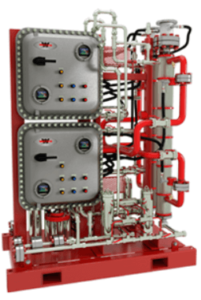Why Heaters in Hazardous Locations Require Temperature Control Panels
Last updated on June 19th, 2023 at 02:43 pm
Hazardous locations are any facility (or section of a facility) containing flammable particles that pose an explosion risk. There are methods to reduce the circulation of these particles and devices, such as using explosion-proof heaters to prevent overheating. However, temperature control panels play a crucial role to ensure heater temperatures don’t exceed safety thresholds.
 Types of hazardous locations and dangers
Types of hazardous locations and dangers
Commonly found substances that pose a risk to staff members include flammable gases, vapors, liquids, dust, fibers, and flyings. There are three types of hazardous locations, which are identified by classes—Class I, Class II and Class III.
Hazardous location classes
- Class I: Facilities where flammable gases or vapors may be present, such as petroleum refineries, aircraft hangars, and utility gas plants.
- Class II: Facilities where flammable or combustible dust may be present, such as plastic production factories, coal preparation plants, and grain elevators.
- Class III: Facilities where flammable fibers of flyings may be present, such as wood processing plants, textile mills, and cottonseed mills.
Classes I and III have subcategories—labeled by letters—to identify certain substances. For example, Class I has a subtype labeled Group A, which the gas acetylene falls under. For Class III, there are Group E substances under which metallic dust, like powdered magnesium, falls.
Use of temperature control panels in hazardous locations
In previous posts, we’ve identified explosion-proof duct heaters as safety equipment for hazardous locations. These devices can facilitate high-temperature applications while simultaneously reducing the risk of circulating and igniting flammable substances. However, industrialists can add another measure to bolster the efficacy of explosion-proof heaters.
Enter temperature control panels. Their main purpose is to maintain a stable temperature while preventing the heating mechanism from overheating itself or its target substance.
Sustaining precise temperature in a hazardous location is vital because surpassing a safe threshold can ignite a flammable substance.
With temperature control panels added to heaters, industrialists can adjust the heating output to a precalculated setting that prevents overheating. Naturally, this level of control can ensure there is no thermal degradation of a target compound.
Temperature control panel uses and features
A wide range of features increases the effectiveness of temperature control panels. They include the likes of moisture and weather-resistant closures, along with relays, fuses, and switches that adjust the heater in real-time for rapid temperature control. But temperature control panels used on heaters in hazardous locations require a unique set of protective features.
Recommended temperature control features for explosion-proof heaters
- Digital controllers: These components display ambient and target temperatures of your medium. With these readings displayed, you can adjust temperatures to remain at the precise and safe predetermined level.
- Electronic high limiter: A limiter automatically shuts heating devices off when they exceed safe temperature thresholds. A thermostat senses the temperature and triggers the limiter if the reading is too high.
- NEMA 7 Enclosures: These enclosures house control panels and are explosion-proof, with housings that separate heating elements from flammable components.
All temperature control panels, including those used in explosion-proof settings, contain standard components, such as thermocouples and RTD sensors. These units allow for more automation, reducing the need for operators to monitor and constantly adjust the heater.
Of course, customization is essential since not all hazardous locations are the same. Here at Wattco, we will customize your temperature control panels based on the required heating output and configurations of your heaters, among other factors. We can also customize the material and layout of your control panels to maximize efficiency and ease of access.
Additional considerations for temperature control panels in hazardous locations
Installing a temperature control panel is not a guarantee of safety—operators must consider additional factors. For example, the location and orientation of the panels matter since their proximity can alter the enclosure’s ability to release or contain heat.
The type of flammable substances all matter as well. For instance, working with flammable dust would mean installing additional protection to prevent it from entering the enclosure. Some applications may even require pressurized air in the panels to decrease explosion risk further.
We build customized temperature control panels to suit various applications conducted in hazardous locations. We will consider all the hazardous substances you encounter, not to mention your application’s temperature and design requirements. This process will ensure you are equipped with the most efficient and safest heating method possible.
Get a quote for your temperature control panels today. Our representatives will help you find the exact setup needed for your industrial needs.
